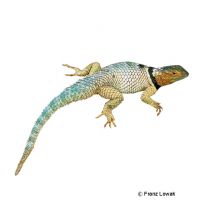Blue Spiny Lizard (Sceloporus cyanogenys)
| Blue Spiny Lizard Sceloporus cyanogenys | |
|---|---|
| Name | Blue Spiny Lizard |
| Name Lat. | Sceloporus cyanogenys |
| Family | Phrynosomatid Lizards |
| Family lat. | Phrynosomatidae |
| Order | Scaled Reptiles |
| Order lat. | Squamata |
| Origin | SW-USA, N-Mexico |
| Habitat | Dry savanna |
| Diet | Insects, veggies |
| Humidity | 50-60 % |
| Behavior | ♂ territorial |
| Keeping | Pair, harem |
| Care Level | Easy |
| Reproduction | Oviparous |
| Housing | Dry terrarium |
| Life Span | 8-12 years |
| Protection | No |
| Metric Units | |
| Size | 25-30 cm |
| Temperature | 28-32 °C |
| Temperature Local | 50 °C |
| Housing Size | 100 x 80 x 80 cm |
| US Units | |
| Size | 10"-12" |
| Temperature | 82-90 °F |
| Temperature Local | 122 °F |
| Housing Size | 40" x 30" x 30" |
Distribution and habitat
Diurnal blue spiny lizards are common in southwestern Texas and northeastern Mexico, where they live in scrub and tree-covered dry savannas and steppes. They shelter from daytime heat and cool nighttime temperatures in rock crevices or under large boulders.
Maintenance
Minimum dimensions for the terrarium, according to the size and number of animals
| 1-2 animals | 5KRL x 4KRL x 4KRL (L x W x H) |
Head-torso length (KRL) is measured on the largest animal. For each additional animal, increase the footprint by 15%. A terrarium of e.g. L 100 x W 80 x H 80 cm is recommended, which should be placed in a quiet and vibration-free place
They need a dry terrarium structured with climbing branches, stone structures (hiding places and privacy screens) and sunning areas, a substrate of sand-loam mixture and boulders, a small water container and potted plants (e.g. euphorbia, aloe, oleander). Back and side walls suitable for climbing (e.g. cork lining) are important. A very small part of the substrate should always be kept moist. Once or twice a week, preferably in the evening, the inside of the terrarium should be finely sprayed with water, but not directly the animals (risk of shock).
| Temp. day: 28-32 °C | Temp. night: 16-22 °C | Temp. local: up to 50 °C | Humidity: 50-60 |
Thermostatically controlled floor heating is recommended. Lighting duration must be 10-14 hrs depending on the season. They need a high light intensity. Special lamps that produce the necessary heat and UV light are ideal. Daily UV irradiation is essential.
Diet
The food supply consists of live insects, such as crickets, house crickets, grasshoppers, cockroaches, millipedes, spiders, zophobas and mealybug larvae, as well as, depending on the individual, vegetables (wild herbs, flowers, fruits). Alternatively, special ready-made food for insectivorous reptiles can be offered, possibly with tweezers for habituation. Wax moths should rarely be fed in very small amounts because of their large fat content. Regular addition of minerals and vitamins (dusting the food) is important. Young animals should be offered food daily, adults 4-5 times a week. Drinking water must always be available
A varied diet promotes health and prevents deficiency symptoms.
Reproduction and breeding
Males usually have a broader head and a thicker tail root, where the hemipenis pockets are clearly visible.
They are viviparous (ovoviviparous). Mating takes place in late fall. The young are born between February and June. A litter consists of 8-18 young. Small insects such as fruit flies and micro-unicates are suitable as initial food for the young. Life expectancy can be 8-12 years
Important
These fast and often somewhat shy animals are good climbers. Adult males behave very territorial and are incompatible with each other.
They need up to 50 °C warm sunny places and a strong temperature reduction at night (room temperature). For the resting phase, the lighting duration is reduced by 2-3 hours and the temperature is lowered to 10-15 °C for about two months.
The quality of the food animals can be upgraded by giving fruit and honey water as food.
The terrarium must have good ventilation without drafts and meet the species specific needs. Measuring devices such as thermometers, hygrometers, etc. are necessary. The lighting has to correspond to the species-specific day-night rhythm and has to be placed in such a way that the animals cannot injure themselves. The terrarium should be locked in such a way that neither unauthorized persons can open it nor the animals can escape. Contamination must be removed regularly
Further literature can be found in your pet store.
References
Text: Christian Sänger; Image: Franz Lowak
Source: BMELV (1997): Mindestanforderungen an die Haltung von Reptilien; ENGELMANN (2006): Zootierhaltung - Tiere in menschlicher Obhut: Reptilien und Amphibien, Harri Deutsch Verlag
- Gemäß § 21 Abs. 5 Tierschutzgesetz idgF
